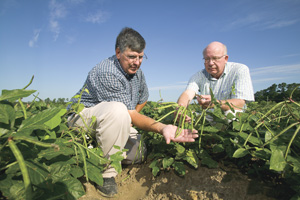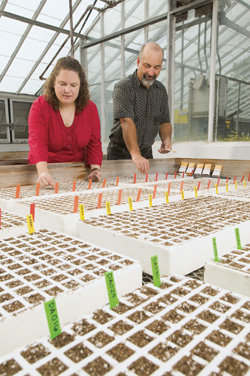
Features
Production
Research
Vegetable breeding steps up to the next level
steps up to the next level
April 1, 2008 By Luis Pons
For almost 70 years, scientists at
the U.S. Vegetable Laboratory (USVL) in Charleston, S.C., have changed
the way many popular vegetables are bred and used.
New work with some favourite food crops
 |
| Technician Floyd P. Maguire (left) and geneticist Richard Fery examine seed and pod quality of a pinkeye-type southernpea advanced breeding line containing the double-green seed trait. |
For almost 70 years, scientists at the U.S. Vegetable Laboratory (USVL) in Charleston, S.C., have changed the way many popular vegetables are bred and used.
Recent examples of this include research by USVL geneticists Mark Farnham and Richard Fery.
Farnham and colleagues at Johns Hopkins University in Baltimore, MD, have found that concentrations of glucoraphanin – a compound associated with the vegetable’s cancer-inhibiting abilities – in broccoli (Brassica oleracea) are influenced more by genetics than by environment.
Farnham says this discovery makes it possible to classify the anticancer potential of different broccoli varieties according to how their glucoraphanin spurs detoxifying enzyme activity in mammalian cells.
Meanwhile, for 19 years Fery has led USVL efforts to develop greener peas. Working with southernpea (Vigna unguiculata) – also known as cowpea, crowder pea, and black-eyed pea – he and colleagues used a gene called green cotyledon (gc) to breed varieties that have now been widely accepted by the frozen-food industry.
Bolstered by a $20 million state-of-the-art facility that opened in Charleston in 2003, Farnham and Fery are pushing their work to new levels, while other USVL scientists pursue different breakthroughs. Fery says with the new facility, which is shared with Clemson University scientists, USVL researchers, “now have all the tools necessary to continue bringing new and improved varieties to consumers.”
 |
| In a greenhouse at the U.S. Vegetable Laboratory in Charleston, South Carolina, research associate Anna Hale and geneticist Mark Farnham plant a broccoli crop to be transplanted into a field and evaluated for seed yield. |
Broccoli: Focus on the seed
Inspired by Johns Hopkins colleagues who found that sprouted broccoli seed has about 10 times more glucoraphanin than the plant itself does, Farnham has expanded his work to include the seed.
He notes that most broccoli seed is expensive. “It’s a crop that’s mainly grown for food, not seed. But this is a new approach. We’re developing inexpensive seed sources that will provide high
glucoraphanin levels. To accomplish this, we’ll wind up breeding a different type of broccoli.
“The new focus doesn’t mean that we’re not interested in broccoli as a vegetable food. But we are looking for new uses of the crop.”
Recently, he and colleagues produced relatively high-glucoraphanin broccoli through crossing types high in glucoraphanin with ones low in the compound. Farnham’s team has also produced and identified broccoli plants very high in glucoraphanin that can successfully pollinate without the help of insects.
Currently, Farnham is working with the private sector to test these self-pollinating lines for seed production.
He adds that USVL’s overall glucoraphanin research may one day lead to extracting the compound from broccoli for pharmaceutical purposes – something he says wouldn’t be cost-effective from the plant, but might be possible from the seed.
In the meantime, Fery is developing “double-green” peas – those whose hues come from combining two unrelated genes.
Peas: A perfect shade of green
“When it comes to these peas, green’s the thing,” says Fery. “You want just the right shade of green – not too dark – and the ability to maintain that colour.”
Varieties of southernpea, which stay green when dry, have long garnered interest from plant breeders. Frozen-food processors like the persistent green seed trait because it greatly enhances the appearance of their product, Fery explains.
Double-green varieties have the gc gene and a gene called green testa (gt). The gc gene was identified in 1993 as being responsible for the green cotyledon trait in another USVL release, the southernpea cultivar Bettergreen. At harvest, dry seeds still have their fresh green colour. The gt gene, discovered in 1974 at Auburn University, imparts a green seed-coat colour that persists in the dry seed.
Fery says that while he and colleagues have developed several superior pinkeye types of advanced breeding lines containing the double-green seed trait, much seed-multiplication and evaluation work lies ahead before a cultivar can be released.
That’s why USVL has established a cooperative research and development agreement (CRADA) with Western Seed Multiplication, Inc., of Wadmalaw Island, South Carolina, for completing the work and bringing this new generation of pea cultivars to market.
USVL and Western Seed, a major grower of cowpea seed stock for the food-processing industry, previously collaborated to develop Charleston Greenpack, which is now the leading southernpea cultivar being packed by frozen-food producers.
Under the present CRADA, the new breeding lines will be evaluated for
commercial-processing suitability and their resistance to the black-eye cowpea mosaic virus.
Watermelon: The call of the wild
Looking ahead, USVL researchers see important developments on the horizon for watermelon (Citrullus lanatus).
For nearly a decade, geneticist Amnon Levi, plant pathologist Judy Thies, and entomologist Alvin Simmons have sought to help watermelon varieties resist field pests, such as destructive fungi, insects, and nematodes.
The three researchers are especially targeting root-knot nematodes (Meloidogyne arenaria, M. incognita, and M. javanica), whiteflies, and spider mites.
Levi says a key part of the trio’s strategy is construction of a linkage map of watermelon’s genes. “The map will be useful in breeding programs because it will help in locating genes that confer disease or pest resistance as well as genes that affect fruit qualities such as shape and size, flesh colour, and sugar content.”
Getting particular attention is the role wild relatives could play in new domesticated watermelon cultivars. “Watermelon … has a narrow genetic base,” says Levi. “This is due mainly to continuous selection for desired fruit quality. As a result, cultivated varieties are susceptible to many diseases and pests.”
On the other hand, he says, wild forms of watermelon collected throughout the world resist various diseases and pests.
Using samples from the collection maintained at ARS’s Plant Genetic Resources and Conservation Unit in Griffin, Georgia, the USVL researchers evaluated wild watermelon varieties and identified a few with resistance to all three targeted nematodes and to other pests.
Thies says that root-knot nematode reproduction and associated root galling that reduces fruit yields occur much less on these wild watermelons than on cultivated varieties, such as Charleston Gray and Crimson Sweet.
“We are attempting to incorporate the pest resistance of the wild watermelons into commercial watermelons so that growers can rely less on chemicals for pest control,” says Simmons. “The linkage map will help us isolate the genes controlling resistance to diseases and pests as well as genes affecting female flower production and fruit quality.”
These latest advancements add to USVL’s legacy, which its researchers have built by working closely with state agricultural experiment stations, particularly Clemson University’s Coastal Research and Education Center, in Charleston. This legacy includes the development and release, over the years, of more than 160 vegetable varieties and breeding lines.
Other current USVL vegetable-improvement studies involve cabbage, cantaloupe, collard, cucumber, leafy vegetables, pepper, snap bean, sweet potato, and tomato as well as crop-protection issues such as weed and insect control and bio-control of plant pathogens.
Luis Pons is with the Agricultural Research Service’s Information Staff.
Print this page